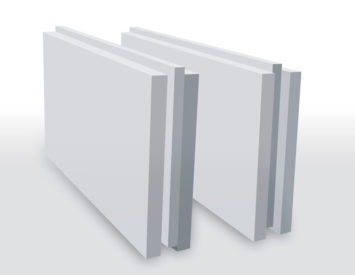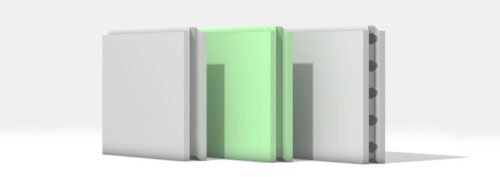Today, the assortment of materials for the implementation of construction and repair work in the apartment is quite large. The choice is made in favor of this or that material, given its price, the quality and characteristics of the room in which the repair is performed. So, in apartment buildings, where the basis of the floor and the ceiling is reinforced concrete floors, partitions are usually erected from light and compact plates. As for interior partitions, in this case, such materials are preferred, such as plasterboard, puzzle drying and foam block. Sometimes the construction of interior partitions from the tree is practiced with their own hands. The technology of installation of each of these materials is not similar to others and should be carried out taking into account all the important rules and nuances. About how to make a intercommercial partition with your own hands from puzzle gypsumblocks - let's tell later in the article.
Content
Characteristics of oxide charts for interroom partitions
- Thanks to the use of this material, it is possible to significantly reduce the estimate for the repair work. So, a plaster of plaster with dimensions 66 by 50 cm can replace brickwork from 15-20 bricks. The puzzle plate of silicate on the surface is the same as the brickwork of 6-7 bricks. Given these indicators, it is possible to save well on the repair work on the construction of interior partitions with their own hands.
- Such plates can be installed in the rooms, the height of the ceiling in which does not exceed 4 m. The layers of material using the "groove-crest" technology are connected. Thanks to such technology between the slabs almost imperceptibly joints. The partition is smooth and solid.
- G-4 and G-5 gypsum gypsum gypsum is used for the production of gypsum puzzle reservoirs. To improve plasticity, various plasticizers are added to it. Almost the data gypsum marks is an environmentally friendly material, which is great for the construction of partitions in residential premises.
Types of puzzle plaster bullocks
Puzzle plates made of plaster are divided into several types:
- Illegible (density of 1100 kg / m³).
- Moisture-resistant (240 kg / m³ density than non-fatty plates). Move with the addition of Portland cement. Usually stain in green.
The first type of plates is used when installing interior partitions of sliding with their own hands in rooms where normal or low humidity indicators are present. The plates of the second type, on the contrary, are used for mounting partitions in apartments, where humidity indicators are above average. Water absorption indicators for the material of the second type reaches 30%. All plates are produced standard size 667 per 50 to 80 cm. They have high indicators of noise and thermal insulation.
By weight distinguish:
- Funny plates. Their weight is about 30 kg.
- Hollow. Their mass is below 20%. Therefore, this type of material can be used even for the construction of interior partitions in a wooden house with their own hands.
Depending on the locking lock, the plates are:
- With a rectangular lock.
- With a trapezoid castle.
Most often, silicate puzzle plates are used for the manufacture of interroom partitions with their own hands. During their production, a high-quality mixture of quartz sand and lime is used. Under the influence of high temperature, the material is pressed, thereby obtaining smooth stoves of standard size. Blocks are highly density, so sufficiently reliable and resistant to mechanical damage.
The most popular manufacturers of puzzle plates are today the following stamps:
- Knauf.
- WHAT.
Interior partition from puzzle plaster bobs with their own hands
Selection of glue and slabs
The first stage must be selection of materials for installation work. Depending on the cost of components, the final estimate of the repair is formed.
For mounting partitions from puzzle plates, several glands options will suit:
- Acrylic.
- Based on gypsum.
- Glue for tiles.
- A mixture of a mortar of cement and plow glue.
The latter option is budget, since acrylic and gypsum adhesive solutions are quite expensive. Alone, the cement solution can be prepared by the proportion of 1 to 3, and then PVA glue is added. And if with the first two embodiments of adhesive compositions, it is possible to work only for 1 hour, then the homemade cement mortar dries a lot longer. Its surplus can be removed using a spatula.
As for the puzzle plates, as already mentioned above, they have good strength indicators, noise and thermal insulation. For the construction of partitions, layers of material are used, an average of 9 cm. They are connected to each other using the "groove-ridge" technology, from which they received such a name. The joints between the plates are obtained practically imperceptible. Hollow layers can be used as an alternative to interior particles from drywall erected with their own hands. If the slab laying is carried out in private homes, then the hollow blocks cannot be used in this case.
Methods of laying with your own hands
As mentioned above, several types of adhesive compositions can be used as the laying base, as well as their own prepared cement mortar. In addition, during the installation, several important rules should be followed:
- Installation of plates should be carried out only in dry rooms.
- It should be pre-prepare a platform for repair work, clearing it from all extra.
- Before making stacking, it is necessary to give the plates to lie down in the room where the installation will be made, at least 24 hours. This time is enough to "get used to" to existing climatic conditions.
The procedure for holding work on the installation of puzzle plates is as follows:
- Blacksmith-sketch of the future interroom partition. Based on the existing calculations, we constitute an estimate of the cost of repair work.
- According to the sketch scheme, we apply markup on the surface where the partition is planned. This requires a construction level, a long ruler, marker. You can use a laser level. It is worth saying that thanks to the technology of "comb-groove", the joints between the plates are pretty durable and imperceptible. Therefore, after the construction of such a partition, an additional applying of a spike layer or plasterboard cladding is required.
- If the room should be inspired, then during the application of the markup, it is necessary to provide a place for laying the heat insulating layer. Thus, from the initial point, an indentation of a length equal to the dimensions of the insulation layer should be made.
- Next, go to the workplate preparation phase. The place where the partition mounting will be made, cleaned with a brush.
- The primer is then applied. To do this, you can use an acrylic primer mixture.
- If there are drops on the working surface of more than 4 mm, they should be aligned using a starting putty or self-determining mixture. The solution is rolled uniformly throughout the surface with a construction roller with a small pile. Otherwise, the adhesion of the puzzle plates will not be durable.
- If the drops on the working surface are too large, then they can be aligned with the use of cement mortar. For this, the cement of brand 500 is taken and stirred with fine-grained sand in a ratio of 1 to 3. The resulting mixture is diluted with water until a paste-shaped consistency is obtained.
- To improve the noise insulating properties of the interior partition and to eliminate its possible oscillations as a result of changing the temperature mode, the damper layer is equipped. For this, a thin cork substrate is used. Its thickness usually does not exceed 5 cm. The substrate is fixed with plaster glue or cement mortar. Then give time so that the adhesive makes it well concluded with the surface and froze.
- Next, go directly to the installation of plates. The correctness of their installation is tested using a construction level. The solution to which the plates are fixed using a spatula. With the same tool we remove the surplus of the construction mixture. Plate laying is carried out "groove up". At the same time, the blocks are mounted in a checker order. Each row shifts to a third, relative to the previous one.
- Plates are fastened to walls and semi perforated corners, which, in turn, are fixed using self-tapping screws.
- If the mounted partition requires a door or window opening, the resulting niche is fixed by a semi-grade of wooden boards. The correct installation is checked using a construction level.
- The resulting gaps between the surface of the ceiling and the puzzle blocks are filled with mounting foam. Small removals on the surface are embedded with cement mortar or other adhesive composition, which was used during the installation of plates. After the glue is dry, you can start a decorative finish of the discogeneous blocks.
















